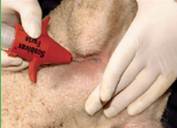Orf
A page about orf infection in sheep describing cause, clinical signs, diagnosis and control.

Introduction
Orf is a contagious disease of sheep caused by a pox virus. It can affect other species less commonly including man. Infected animals often recover in a period of weeks though carrier sheep may harbour infection and act as a source for other animals for long periods. The clinical consequences of infection are determined by the strain of virus, the immune resistance of the animal infected and other factors. Various strains have varying ability to cause mild or serious disease.
Aetiology
Orf, also known as contagious pustular dermatitis, which can affect sheep and goats though may also cause disease in other species including man. It is caused by a parapox virus.
Epidemiology
The clinical consequences of infection are determined by the strain of virus, the immune resistance of the animal infected and other inciting causes e.g. damage to sheeps muzzles by thistles. Various strains have varying ability to cause mild or serious disease. Immunity can be lowered by feed shortage, inclement weather, transport, dietary change, stress of lambing etc. Other concurrent diseases may influence the severity of an outbreak. One of the most common sources of infection is adult carrier sheep with localised lesions that remain unnoticed. This source can then result in spread to the lambs muzzle, one of the most common clinical findings in orf infection. If the lesions spread into the mouths of lambs orf may prevent suckling and cause weight loss. Lesions can spread to a ewes teats, resulting in mastitis (as the ewe fails to suckle with the pain of the ulcerated teats). Sheep can be re-infected and immunity is not life-long. The virus is also somewhat persistent in the environment lasting up to 6 weeks in dried scabs that are unexposed to adverse weather conditions.

Clinical Signs
In sheep and goats the scabs mostly appear on or near the lips and muzzle, occasionally initially appearing on and in the nostrils, around the eyes, on the thigh, above the hooves, on the vulva, udder or inside under the forelimb.
In young lambs, lesions can travel inside the mouth and animals can die of starvation. More typically sheep will become free of orf within a few weeks or so as the disease runs its course.

Diagnosis
Clinical signs of orf are highly indicative of infection but laboratory tests are required for a definitive diagnosis.
Isolation of the organism
Samples (that can be submitted for culture and identification of the virus as the causal agent in disease) include scabs from affected areas.
Post mortem examination
Orf is rarely fatal. However in young lambs, disease may be confirmed on post mortem examination with microscopic findings of classical lesions.

Control
Control of orf is based on four equally important aspects:
- Biosecurity – Maintaining biosecurity involves avoiding introduction of infected animals into the herd and/or implementing stict isolation / quarantine of introductions until proven negative, and restricting access of livestock to external sources of infection e.g. double fencing is in place at all perimeters, restricting access of other sheep to the farm etc.
- Vaccination – The vaccine is useful in reduction of clinical disease. For more on vaccination please consult your local veterinary practitioner.
- Treatment and segregation of clinical cases: Sheep farmers can apply antibiotic sprays on to larger lesions, while ensuring infected lambs receive sufficient milk and separating out the infected stock to slow down disease transmission to healthy animals is very important. It is advisable for those handling infected animals to wear gloves to prevent cross-infection and self-infection.
- Selective culling? – Reduction of circulating virus can best be achieved with the introduction of a vaccination program. However, progressive culling of those animals that are identified as a potential source of the virus is not economically feasible – to find and cull all the carrier animals is virtually impossible as some may have tiny lesions that are difficult to find on gross examination.
